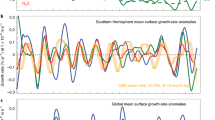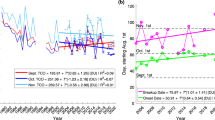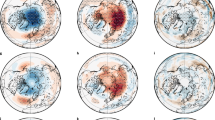Abstract
High concentrations of ozone are found in the Earth's stratosphere, but strong stratification suppresses efficient exchange of this ozone-rich air with the underlying troposphere. Upward transport of tropospheric trace constituents occurs mainly through equatorial deep convective systems. In contrast, significant downward transport of ozone-rich stratospheric air is thought to take place only outside the tropics by exchange processes in upper-level fronts associated with strong distortions of the tropopause1. Ozone within the tropical troposphere is assumed to originate predominantly from ground-based emissions of ozone precursors, particularly from biomass burning2, rather than from a stratospheric source. Recent measurements of ozone in the upper troposphere in convective regions over the Pacific Ocean3 indeed reveal near-zero concentrations. Here we present sharply contrasting observations: ozone-rich (100–500 parts per billion by volume) transients were frequently encountered by specially equipped commercial aircraft at a cruising altitude of 10–12 km (in the upper troposphere) in the vicinity of strong convective activity over the equatorial Atlantic Ocean. This strongly suggests that the input of stratospheric ozone into the troposphere can take place in the tropics. We suggest that this transport occurs either by direct downward movement of air masses or by quasi-isentropic transport from the extratropical stratosphere.
This is a preview of subscription content, access via your institution
Access options
Subscribe to this journal
Receive 51 print issues and online access
$199.00 per year
only $3.90 per issue
Buy this article
- Purchase on Springer Link
- Instant access to full article PDF
Prices may be subject to local taxes which are calculated during checkout


Similar content being viewed by others
References
Holton, J. R. et al. Stratosphere-troposphere exchange. Rev. Geophys. 33, 403–439 (1995).
Crutzen, P. J., Heidt, L. E., Krasnec, J. P., Polloc, W. H. & Seiler, W. Biomass burning as a source of atmospheric trace gases CO, H2, N2O, NO, CH3Cl and COS. Nature 282, 253–356 (1979).
Kley, D. et al. Observations of near-zero ozone concentrations over the convective Pacific: effects on air chemistry. Science 274, 230–233 (1996).
Marenco, A., Nedelec, P., Thouret, V. & Grouhel, C. in DLR-Mitteilungen (eds Schumann, U. & Wurzel, D.) 94-06, 26–31 (DLR, Ober Pfaffen Hofen, (1994).
Marenco, A. The MOZAIC programme. EUROTRAC Newsl. 17, 2–7 (1996).
Andreae, M. O. et al. Influence of plumes from biomass burning on atmospheric chemistry over the equatorial and tropical South Atlantic during CITE-3. J. Geophys. Res. 99, 12793–12809 (1994).
Delany, A. C., Haagensen, P., Walters, S., Wartburg, A. F. & Crutzen, P. J. Photochemically produced ozone in the emissions from large-scale tropical vegetation fires. J. Geophys. Res. 90, 2425–2429 (1985).
Griffing, G. W. Ozone and oxides of nitrogen production during thunderstorms. J. Geophys. Res. 82, 943–950 (1977).
Shlanta, A. & Moore, C. B. Ozone and point discharge measurements under thunderstorms. J. Geophys. Res. 77, 4500–4510 (1972).
Orville, R. E. Ozone production during thunderstorms, measured by the absorption of ultraviolet radiation from lightning. J. Geophys. Res. 72, 3557–3561 (1967).
Clarke, J. F. & Griffing, G. W. Aircraft observations of extreme ozone concentrations near thunderstorms. Atmos. Environ. 19, 1175–1179 (1985).
Vömel, H., Oltmans, S. J., Kley, D. & Crutzen, P. J. New evidence for the stratospheric dehydration mechanism in the equatorial Pacific. Geophys. Res. Lett. 22, 3235–3238 (1995).
Russel, P. B., Pfister, L. & Selkirk, H. B. The tropical experiment of the stratosphere-troposphere exchange project (STEP): science objectives, operations, and summary findings. J. Geophys. Res. 98, 8563–8589 (1993).
Lilly, D. K. Cirrus outflow dynamics. J. Atmos. Sci. 45, 1594–1605 (1988).
Roach, W. T. On the nature of the summit areas of severe storms in Oklahoma. Q. J. R. Meteorol. Soc. 93, 318–336 (1967).
Burnham, J. Atmospheric gusts—a review of the results of some recent research at the royal aircraft establishment. Mon. Weath. Rev. 98, 723–734 (1970).
Cornford, S. G. & Spavins, C. S. Some measurements of cumulonimbus tops in the pre-monsoon season in north-east India. Meteorol. Mag. 102, 314–332 (1973).
Danielsen, E. F. Adehydration mechanism for the stratosphere. Geophys. Res. Lett. 9, 605–608 (1982).
Danielsen, E. F. In situ evidence of rapid, vertical, irreversible transport of lower tropospheric air into the lower tropical stratosphere by convective cloud turrets and by large-scale upwelling in tropical cyclones. J. Geophys. Res. 98, 8665–8681 (1993).
Knollenberg, R. G., Kelly, K. & Wilson, J. C. Measurements of high number densities of ice crystals in the tops of tropical cumulonibus. J. Geophys. Res. 98, 8639–8664 (1993).
Sun, J., Braun, S., Biggerstaff, M. I., Fovell, R. G. & Houze, R. A. J Warm upper-level downdrafts associated with a squall line. Mon. Weath. Rev. 121, 2919–2927 (1993).
Newell, R. E., Zhu, Y., Browell, E. V., Read, W. G. & Waters, J. W. Walker circulation and tropical upper tropospheric water vapor. J. Geophys. Res. 101, 1961–1974 (1996).
Appenzeller, C., Davies, H. C. & Norton, W. A. Fragmentation of stratospheric intrusions. J. Geophys. Res. 101, 1435–1456 (1996).
Newell, R. E. et al. Vertical fine-scale atmospheric structure measured from NASA DC-8 during PEM-West A. J. Geophys. Res. 101, 1943–1960 (1996).
Browell, E. V. et al. Large-scale air mass characteristics observed over Western Pacific during summertime. J. Geophys. Res. 101, 1691–1712 (1996).
Acknowledgements
We thank Air France A340 pilot De Boysson for eye-witness information from MOZAIC flights in the tropics; we also acknowledge discussions with many of our colleagues. On behalf of the MOZAIC programme, we thank Air France, Lufthansa, Austrian Airlines and Sabena, who agreed to carry the MOZAIC equipment free of charge. This work was supported by the European Commission DG XII and Centre National de la Recherche Scientifique (CNRS-INSU); satellite images were made available by NOAA-SAA.
Author information
Authors and Affiliations
Corresponding author
Rights and permissions
About this article
Cite this article
Suhre, K., Cammas, JP., Nédelec, P. et al. Ozone-rich transients in the upper equatorial Atlantic troposphere. Nature 388, 661–663 (1997). https://doi.org/10.1038/41749
Received:
Accepted:
Issue Date:
DOI: https://doi.org/10.1038/41749
Comments
By submitting a comment you agree to abide by our Terms and Community Guidelines. If you find something abusive or that does not comply with our terms or guidelines please flag it as inappropriate.



